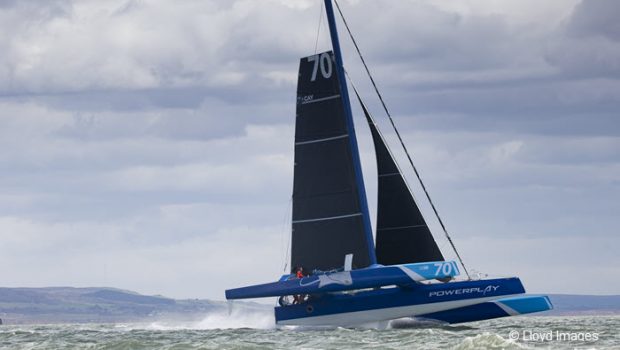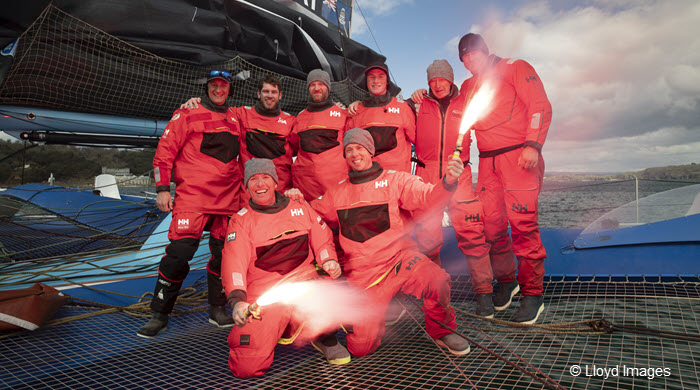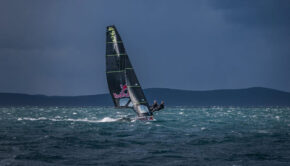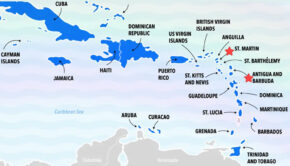Blowing away the lockdown dust
Published on April 8th, 2021
Envisioned as offering offshore class racing, the MOD70 never got fully off the ground in that capacity, but the trimaran has proven to be a beast when the ocean gets angry.
Now a reliable ocean record weapon, Peter Cunningham’s MOD70 PowerPlay did just that by crushing the original Fastnet Course of 595 nm, starting from Cowes before passing around the Fastnet Lighthouse and finishing at the Plymouth Breakwater.
Joining the crew of Cunningham, Ned Collier Wakefield, Tom Dawson, John Hamilton, Jack Trigger, Miles Seddon, and Martin Watts was Paul Larsen who himself holds the 500m world speed record of 65.45 knots.
With the team starting from England shortly after midday on April 5, Larsen details life onboard during this record breaking effort:
Well that sure blew away any lockdown dust.
After a few days training around the Solent and the Isle of Wight in rather warmer southerly winds, we went on standby for any weather windows that would allow us to fire the weapon in anger at any of the “backyard” records.
Whilst the focus for the Round the Isle of Wight record has been in Southerly winds, the recent cold N/NE winds did show promise with the added potential of leading straight into a Fastnet course record attempt.
Once Ned put the call out and Miles sent through the forecast, my first thought was, “This is going to be cold.” I’m sure we all took extra note of the temperature as we left the warmth of our houses and made our way to the boat.
The northerly change blew in cold and crisp as we peeled the covers off in Hamble River around 0700 in the morning.
The Round the Island record (RTI, around the Isle of Wight) is a tough one as we’re pretty much racing like for like with respect to who holds the record. Phaedo was practically the same boat and she smashed out the 50 nautical mile lap in two and a half minutes over two hours.
We know that seconds count on this course.
Although the northerly winds showed it was doable on the routing, even suggesting the possibility of sub two hours, the reality was that the holes in the wind would take more than the gusts would give. The manoeuvres would have to be spot on so we had the extra grunt of Dom Davies on the grinders.
We did a sighting run down the Solent to the Needles to get a feel for the right configuration and real potential for a record run. Our worries were realized each time PowerPlay sagged down to low 20s between the gusts. It was hard work for the trim team.
There was the added concern that every hour we lost focusing on the RTI record would steal from the Fastnet record time as tidal gates at the big headlands would start to flow against us. The decision was made, much to Dom’s disappointment, to can the RTI attempt and focus on the more likely Fastnet attempt.
We sailed back to Cowes and dropped Dom off. Taking one more person on this offshore record would mean we would need to take another life raft but perhaps more importantly, would start to get pretty cramped onboard.
If it were warmer, the possibility would exist of spending hours sitting up on the high side adding valuable righting moment to the boat. The sub zero wind chill quickly wiped that option out. This would be a high apparent wind speed run.
We had all the gear on with respect to thermals but still the cold seeped in. Glove choices were a hot topic. Pip Hare was down near Lands End and sent some pictures of the conditions awaiting us. It looked pretty wild.
So we set off on the 595-mile Fastnet course with two reefs and staysail up just after midday. It was bloody great to be chasing the clock in anger again. The sheer length of lockdown leaves you wondering if some things will ever return.
PowerPlay punched her way out the Solent, turned right along the coast and then just started doing her thing. Damn these boats are impressive. From start to finish we had to work hard. The wind was rarely steady and we spent much of the attempt sailing in the 80-110 degree wind angle zone.
We never had full mainsail up and never used the gennaker. We did see a fair bit of reef 3 and our smallest J3 jib action. It was obvious by Poole that this was going to be uncomfortable… and hard work.
The MODs have this industrial power and efficiency aspect about them… much like a totally stripped out and poorly pressurised large commercial jet. In difficult and windy conditions, these boats are basically fuelled by their own speed but driven by human suffering, the latter of which they lack any empathy for.
The landmarks of Poole, Portland Bill, Start Point, and the Lizard all flew by our right side in rapid procession. Long rumbling runs over 30 knots all fired precious time in our record run bank. We were hitting high 30s often and although we saw high 39s, I didn’t see a 40. That said, the log recorded a 41 knot burst.
I hadn’t actually driven a MOD for a couple of years or so but the nerves quickly found familiarity once settled in the comfy embrace of one of the best seats in yachting. Time spent sailing foiling A-Class cats has greatly assisted my comfort levels in pushing these boats.
The high-speed upwind foiling modes that the A-Class has is all about finding modes that at first don’t feel natural and certainly not comfortable. You learn how to make them so, then you seek them out, then you crave for them.
For the watch system we simply partnered up with our own crew-role equivalents and backed each other up more to the demands of the course than the clock. I was to be sharing the driving with Ned and Peter. I made sure to try and get off decks once not needed in order to conserve warmth and stay sharp for what was going to be a very demanding 24-26 hours.
Changing out of all the wet weather gear to climb into a dry bunk was too time consuming as the sail changes were coming as thick and fast as the headlands. The boys on the pumps, in the pit, and on the howling foredeck were doing solid work ripping through the gears. I reckon they were happy to do anything to generate heat.
The relatively short run from the Lizard to Lands End was memorable. With the wind forward of the beam, we were down to 3 reefs and the small jib. The combinations of wind and tide had jacked up the sea state. With such a low centre of effort from the sail plan, the windward hull would often hit a crest and blast freezing knives of spray across the deck.
I saw over 50 knots of apparent wind speed and from behind the windscreen of the helm station could hear the wind screaming through the nets, lifelines, and rigging. It was hard to believe that the tiny sail plan could launch the sheer windage and drag of the trimaran platform forward into the melee of apparent wind at such pace.
The thought was in my mind to watch the speed and “Heave” of the boat so that I don’t get launched high and nose up off any unusual waves, as there are times when simply the windage of the whole platform can grab hold and dominate the whole balance equation.
I worried about the strength of the small windscreen. Sailing west into the late evening sun was blinding. I couldn’t see any instruments and only unbearable pain waited every time I stuck my head above the spray blasted windscreen.
I reckon if that item failed at this stage we would have been heavily compromised. Later the other side blew off and nearly took Ned out. Thankfully it was after the worst and just before we turned the corner.
A much more open water sea state was waiting once we got around the corner and out from the protection of English shores. We could still head straight at the next mark, the Fastnet rock itself, but now it was rough.
The sea state limited how fast we could go. We’d put a lot of time in the bank and now it was wise to spend a little conserving a boat that would happily launch itself to destruction if allowed.
Things settled and once again we went through all the gears to make good time to the rock. John, Krusty (Martin), Dawson, and Trigger had put in a big effort working relentlessly through the sail changes. I reminded them to take breaks and get below whenever they could.
Miles switched in and out between Nav and grinding whenever needed. Although I felt fine… I was on my second spew. Anything I ate or drank just bounced. Too many months sailing the couch. I wasn’t alone…
We trimmed and weaved from cloud to cloud across the Irish Sea until the lighter approach and rounding of the Fastnet Rock offered brief respite. The rounding was without fanfare as were keen to simply tick it off and head home.
The record clock stole some time back here until we separated from the Irish coast and got back into it. Dawson made me hot porridge and a cup of coffee. Nice try… spew three!
The blast into the Scillies was fantastic. As the smallest glow of pre-dawn faintly warmed the horizon on my left, the sliver of a moon rose directly on course giving me the perfect beacon to aim at. The true wind angle opened up to around 120 degrees and PowerPlay was alive.
It has these modes where once you have accelerated and managed to contain the heaves of roll and pitch, it settles into a fast and flat state where you can lean on it hard as you like. The nose stays high as with any good horse and it just bolts off into the mid-high 30s.
The rumble you feel through the tiller goes hard. It’s as if you’re now rolling down the highway in a hard wheeled trolley as against carving through water. You need to get the centerboard height and foil pitches right but once there… it kinda looks after itself.
Seeking out and setting up these fast, safe modes is what allows singlehanded sailors to do the incredible things they do on these boats under autopilot.
Having the moon low on the horizon dead on course is one of the greatest luxuries in sailing. It took my mind off the cold and discomfort and made me ponder how grateful I was to be launching this beast one more time.
There will be a time when even this is purely a memory and these moments are the sweet ones that will bring a smile of a life lived.
We arrived at the Scillies in daylight. At this stage, although fading, we still thought a 24-hour record run might be possible. We passed very close to the jagged rocks off the SW tip of the Scillies and once set-up, headed for England again.
I went and collapsed in a soaking pile in the aft bilge, pulling the cold mesh of the J3 sail bag over me more for psychological warmth than any real benefit. I could tell when we cleared the Scillies as the pace got frantic once more. Fantastic. The fire hose of time fired back into our record bank.
After a brief rest I could actually describe as sleep, I popped up to see we were back under 3 reefs and J3 and smoking. If she held together, it was no longer about breaking the old record but rather setting the new one.
Ned’s stretch from the Scillies to Falmouth had us focusing with renewed vigour back on the possibility of a sub 24 hour Fastnet run. We were quick but alas, some rain clouds slowed us across Mounts Bay. Despite rapid gear changes which helped us claw our way through, we were now running out of runway.
The blast to the finish was fast. We thought we were about 15 minutes out. As Peter steered us under light snow over the Plymouth breakwater finish line so many of you all know so well, a familiar voice came over the VHF from WSSRC record commissioner Mike Ellison.
(Mike had lived with us for months at a time down in Namibia as World Sailing Speed Record Council observer for most of our Sailrocket world record attempts).
Some confusion between British Standard Time and UST at starts and finishes had us at 24 hours 4 minutes and 18 seconds. This was later corrected to actually be 25 hours 4 minutes and 18 seconds. I’m not sure if that made it better or worse. Either way… it was sweet to turn off the machine at the end of an epic run.
A RIB met us and I’ll admit, any vegetarian aspirations were discarded when the hot pizzas came onboard. They were inhaled and stayed there… thankfully.
Overall, I think we can be very happy with how that was sailed. I honestly can’t think of one wrong sail call or change. The work ethic of the crew in very draining conditions was impressive.
We never left anything in the air longer than it was needed and jumped at any opportunity presented to steal any time we could. In hindsight we could have saved a little time in places… but that is only with what we know now. At the time the calls were all solid.
The mighty PowerPlay performed flawlessly. I think these MODs are one of the greatest offshore race boats ever built. They just deliver every time. Touch wood, this boat has finished every punishing race, or delivery I’ve personally done on it at 100 percent capacity.
With newer bigger boats constantly coming online, sure there are faster boats… but these MODs deserve to be looked on from an offshore sailing perspective with the same reverence and fondness bestowed on the real classics from other fields.
The P-51 Mustangs and F18 Hornets, the Group B Quattros and Porsche 965s, the NSR/YZR 500s. Thrilling machines that reliably deliver the goods time and again… like the MOD70!
I can only thank Peter Cunningham for allowing that boat to feed off my suffering one more time. As I tap this out on still numb fingers, I can only admire the fact that he rode that one out as he approaches his 80th year. Bloody impressive.
Didn’t think I’d be so happy to get back on the couch.










 We’ll keep your information safe.
We’ll keep your information safe.